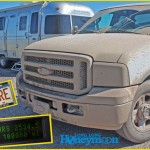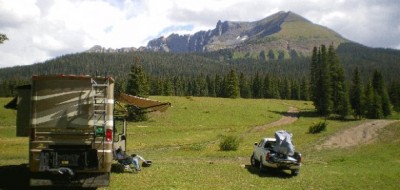By Bob Difley
 Most RVers who have gotten past the newbie stage have camped overnight at least once or twice without hookups, for instance in a Walmart parking lot, at a rest stop along an interstate highway, at an RV rally, or in a forest service campground.
Most RVers who have gotten past the newbie stage have camped overnight at least once or twice without hookups, for instance in a Walmart parking lot, at a rest stop along an interstate highway, at an RV rally, or in a forest service campground.
Discovering how to camp where there are no hookups is not difficult, since all modern rigs were designed to be self-contained and self-reliant and most RVers once they get a little familiar with their rig have tried it.
But the real trick to successful camping without the restrictions imposed by hook-ups–what RVers call boondocking–is knowing how to get that third, fourth, or fifth day – or even a week or more – out of a boondocking campsite. And not just surviving, but becoming completely comfortable and confident doing it. The trick is in managing your resources–water, electricity, and waste.
If you familiarize yourself with these resources you will be able to judge how many days you can camp without running out (or filling up) and needing to take care of your onboard systems. For instance, monitor your electrical usage with a multi-meter and how fast you deplete it from your batteries. Watch your drinking water tank level and how much you waste (and the resultant waste water filling up your gray water tank). Also check your black, or sewer, tan and how fast you fill it. Then practice ways to conserve.
Getting as many days in the boonies as you can squeeze in between having to pack up camp and drive off to replenish electricity (charging your batteries), fill your water tank, and dump your waste tanks, is what makes boondocking successful, and staying out longer – and doing it comfortably – is what makes a boondocker happy.
It also takes experience. Every time you boondock, you learn a new trick or two to extend your stay. These simple, common sense acts, that with experience become second nature – like not letting your faucets run, taking Navy showers, re-using the water you run when waiting for hot water to come, reducing the amount of waste water you let flow into your gray tank, turning off lights and TV when not being used – will eventually become habits that you will practice automatically without a second thought. You might even find out you are becoming a bit more conservative and less wasteful when at home.
Look at it this way. If you were just as comfortable without hookups as you were with them, where would you rather camp? With neighbors within 15 or so feet on either side of you, or would you choose campsites where your nearest neighbors were 50 or 100 feet or further away? Or you had no neighbors at all.
That’s the beauty of boondocking. Once you learn the tips and tricks, your options are endless – from a crowded LTVA at Quartzsite to a solitary campsite with sweeping vistas and no sign of civilization in sight.
For more RVing articles and tips take a look at my Healthy RV Lifestyle website, where you will also find my ebooks: BOONDOCKING: Finding the Perfect Campsite on America’s Public Lands (PDF or Kindle), 111 Ways to Get the Biggest Bang for your RV Lifestyle Buck (PDF or Kindle), and Snowbird Guide to Boondocking in the Southwestern Deserts (PDF or Kindle), and The RV Lifestyle: Reflections of Life on the Road (Kindle reader version). NOTE: Use the Kindle version to read on iPad and iPhone or any device that has the free Kindle reader app.


